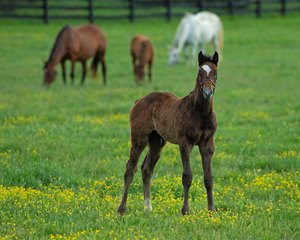New Equine Virus Tied to Rise in Foal Diarrhea Cases


A new Rotavirus not previously seen in horses is the culprit behind a rash of foal diarrhea cases seen during the first several months of the year at farms in Central Kentucky, according to researchers at the University of Kentucky's Maxwell H. Gluck Equine Research Center and the Veterinary Diagnostic Laboratory.
Because the virus is a different strain it could not be detected using existing diagnostic tests for equine Rotavirus A and also the currently available commercial vaccine does not provide any protection.
"This is not a mutation. This is a whole different virus for horses," said Dr. David Horohov, chair of the Department of Veterinary Science and director of the Gluck Equine Research Center.
Veterinarians began seeing signs that something was amiss during the first couple of months of the year.
"What we were seeing was a significant increase in cases on some farms compared to what they'd seen in the past, which indicated the vaccine was not being effective," Horohov said. "It was this intensity in the cases that alerted us, not something that was scattered across a lot of farms."
Despite the increase in cases, UK has not reported any increase in foal mortality.
Efforts are underway to better characterize the virus and determine its role in the current outbreak. Additional investigations are also underway at UK to identify other possible causes, and researchers are sending out an epidemiological survey to farms to better understand the outbreak.
Both the Gluck Center and the Veterinary Diagnostic Lab recommend strict biosecurity protocols as the best protection strategy at this time.
Foals commonly develop diarrhea a week to 10 days after foaling, and veterinarians and farm owners typically have the experience and tools to respond. According to the American Association of Equine Practitioners, it is important for a veterinarian to evaluate foals under a month old when they experience diarrhea because they can develop life-threatening dehydration in as few as six to eight hours.
Neonatal or young foals have a digestive tract, similar to humans, where small intestines are responsible for much of their nutrition absorption. Dealing with this type of attack on the small digestive system heavily impacts foals, which was a key reason the Gluck center will focus its research efforts on this issue.
UK College of Agriculture, Food, and Environment researchers have developed a multi-pronged research plan to help further the understanding of the problem. With limited Koller Emergency Funds available, the Gluck Center received additional dollars provided by the Kentucky Thoroughbred Owners and Breeders Foundation, The Grayson-Jockey Club Research Foundation, and Coolmore America that allowed research to begin immediately.
"The foundation members met March 15 and felt this research and timing was consistent with the sole mission of immediately responding to threats to the breeding industry in Central Kentucky. We are grateful to Gluck for accessing their emergency funds and everyone for responding so quickly," said Jimmy Bell, chairman of the KTOB Foundation.

The plan includes expanding scientists' knowledge of the foal gut environment to improve their understanding of neonatal gut bacteria and the effect of antibiotic treatment; using gene sequencing to analyze the gut microflora of mares and their foals on farms both with and without early neonatal diarrhea cases and study the effect of antimicrobial drug treatment; and, investigating a biotherapeutic approach on one farm with a home-fermented live yogurt supplement instead of a commercial pre/probiotic. Data from other species supports Lactobacillus spp. as promoting gut health and outcompeting pathogens in gut colonization.
In addition to the three studies, the UK Gluck Center and Veterinary Diagnostic Laboratory team has identified further potentially useful tests, including gene sequencing targeting identification of novel viruses and bacteria that may be present.
Because the novel Rotavirus has not been seen in horses before, an entirely new vaccine will need to be formulated, according to Horohov.
"If it was a mutation, it could all be done relatively quickly," he said. "As it is, the developer will have to first be able to grow the virus in order to manufacture the vaccine. Because this is a new virus, it may require relicensing, and then there is testing and getting USDA approval. We are looking at at least a year but it could take longer. COVID-19 has changed everything."
